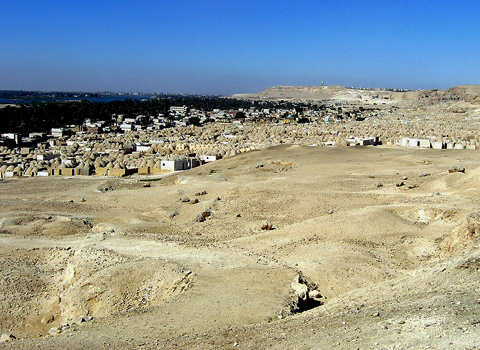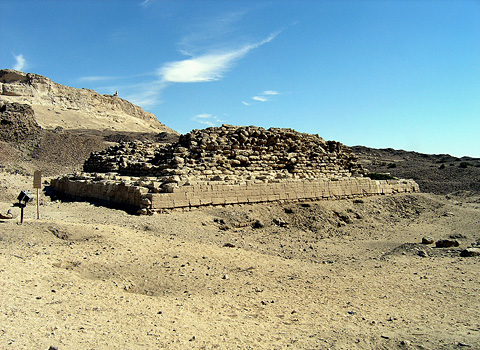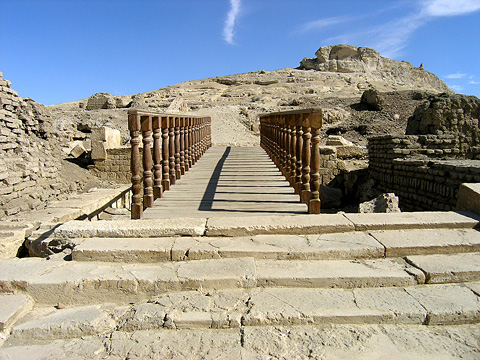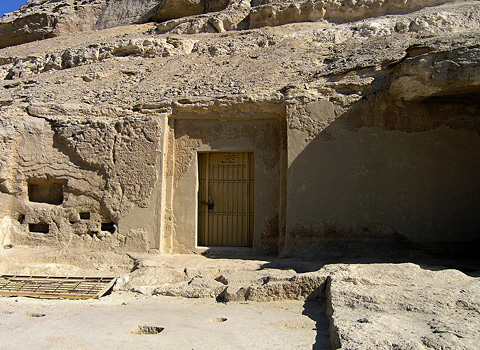Zawyet el-Maiyitin
A small Dynasty III pyramid stands on a site which seems to have many names. Locally it is known as Zawyet Sultan, but in textbooks it is often named Zawyet el-Maiyitin or Zawyet el-Amwat, although the associated ancient Egyptian town of Hebenw is usually known as Kom el-Ahmar. Here, about 7km south of el-Minya on the east bank of the Nile, are the important remains of a city which was at one time capital of the 16th Upper Egyptian nome, whose symbol was the oryx.

The step pyramid, one of a series of seven similar structures throughout Egypt, perhaps marked the ancient proto-capitals and are mostly ascribed to King Huni. The area of Zawyet el-Maiyitin had been in use as a necropolis since Predynastic times and with additions right through to the Ptolemaic and Roman eras. Today, adjacent to the archaeological site, a vast old Muslim cemetery, its domes stretching almost from the river up into the gebel is one of the largest in Egypt, which until recently served the whole population of el-Minya governorate. In the gebel behind the town site rock-cut tombs served as the burial places of local officials of the Old and New Kingdoms.

Books will tell you that there is little left of the destroyed step pyramid, so I was surprised to see just how large the structure still is. Originally constructed in four steps with sides measuring 22.5m and rising to an estimated height of 17m, the lower step now stands at around 5m. Remains of its limestone casing still survives in up to five courses in some places. No burial chamber has ever been found, suggesting that the pyramid, like others of its type, was never intended as a mortuary monument.
The city of Henenw was named from the Egyptian Hbn, meaning ‘to kill with a knife’ and is said to originate in the legend of Horus, the principal deity of the area who killed his uncle Set to revenge the death of his father Osiris. Remains of the mudbrick town are extensive, with high enclosure walls 6.75m thick.

Scant remains of a temple can be seen on the northern side of the site. This is dated to Amenhotep III and was dedicated to Horus of Hebenw. Amenhotep’s temple seems to have been dismantled and rebuilt by Seti I during Dynasty XIX and there are a few remaining blocks depicting Seti’s cartouche near a wooden ramp over the quay area. Stone steps leading into the temple were built in the pharaonic and Roman periods, but little else remains.

The rock-cut tombs are situated about 1km across the town site to the east, up a steep slope on the hillside. The only tomb open at present belongs to Nefersekheru, a royal scribe during late Dynasty XVIII or early Dynasty XIX. The tomb is not well-preserved but still contains some reliefs on its walls and a deep burial shaft. There is also ongoing excavation around the Old Kingdom tomb area at the foot of the gebel where the tomb of Khunes has been uncovered.
How to get there
Zawyet el-Maiyitin is on the east bank of the Nile in the el-Minya province of Zawyet Sultan and a little to the north of Istabl Antar (Speos Artemidos). The Muslim cemetery is very prominent on the eastern side of the road next to the site of the pyramid.
